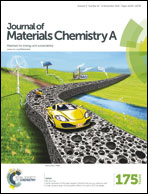CdTe based quantum dot sensitized solar cells with efficiency exceeding 7% fabricated from quantum dots prepared in aqueous media†
Abstract
CdTe quantum dots (QDs) with a narrow band gap and high conduction band (CB) edge provide great potential for the fabrication of QD sensitized solar cells (QDSCs). Herein, a convenient aqueous route was adopted to synthesize CdTe core QDs for the construction of type-II core/shell QD sensitizers. First, mercaptopropionic acid (MPA) capped water-soluble CdTe QDs were synthesized in aqueous media. After tethering the CdTe QDs onto a mesoporous TiO2 photoanode, CdTe/CdS and CdTe/CdSexS1−x type-II core/shell QD sensitizers were formed by post-depositing CdS and CdSexS1−x shell materials over the photoanodes via a successive ionic layer adsorption and reaction processes (SILAR), respectively. A wider light harvesting range together with a wider photoelectronic response range was observed in the resultant CdTe/CdS and CdTe/CdSexS1−x core/shell QD based solar cells relative to plain CdTe cells. Simultaneously, suppressed charge recombination processes has also been confirmed by impedance spectroscopy (IS), and open-circuit voltage decay (OCVD) characterizations. Consequently, compared to the plain CdTe QDSCs, the power conversion efficiencies (PCEs) for CdTe/CdS and CdTe/CdSeS were enhanced by 22 and 35%, respectively. With the optimization of CdSexS1−x shell thickness, a PCE of 7.24% under the illumination of one full sun was obtained.


 Please wait while we load your content...
Please wait while we load your content...